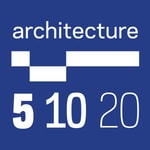Architecture 5 10 20 – Détails, épisodes et analyse
Détails du podcast
Informations techniques et générales issues du flux RSS du podcast.

Architecture 5 10 20
Guy Geier
Fréquence : 1 épisode/34j. Total Éps: 38

Classements récents
Dernières positions dans les classements Apple Podcasts et Spotify.
Apple Podcasts
🇨🇦 Canada - management
18/07/2025#86🇬🇧 Grande Bretagne - management
16/05/2025#100🇨🇦 Canada - management
25/04/2025#64🇨🇦 Canada - management
19/04/2025#72
Spotify
Aucun classement récent disponible
Liens partagés entre épisodes et podcasts
Liens présents dans les descriptions d'épisodes et autres podcasts les utilisant également.
See all- https://surroundpodcasts.com/
57 partages
- http://www.fxcollaborative.com/
44 partages
- https://www.aia.org/
25 partages
- https://www.instagram.com/arch51020fxc
39 partages
- https://www.instagram.com/shantell_martin
12 partages
- https://www.instagram.com/juliebrown_bd
10 partages
Qualité et score du flux RSS
Évaluation technique de la qualité et de la structure du flux RSS.
See allScore global : 59%
Historique des publications
Répartition mensuelle des publications d'épisodes au fil des années.
Sustainability Milestones: Adaptation and Resilience
Épisode 35
mercredi 9 avril 2025 • Durée 32:34
Welcome back to Architecture 5 10 20! I’m your host, Guy Geier, Managing Partner of FXCollaborative Architects in New York. My guests for this podcast are pioneers and visionaries shaping the future of the built environment across various disciplines. Join me in exploring their remarkable journeys, discovering how they reach their current heights, and envisioning what lies ahead in the next 5, 10, and 20 years.
Join me for this episode as I have an insightful conversation with Ilanah Judah, a former colleague of mine at FXCollaborative and now Americas Climate and Sustainability Leader at Arup. It has been so exciting to watch her grow into a major voice in climate resilience, and she brings a wealth of experience and clarity to a topic that is far too often misunderstood or oversimplified.
Ilana unpacks what resilience really means in the context of the built environment and discusses why it’s not just a checklist of add-ons. She explains how resilience differs from sustainability (even though they are deeply interconnected) and shares why thinking about resilience as an unbroken chain is so important for meaningful impact.
Ilana and I talk through what a resilience journey can actually look like, from risk assessments and future scenarios to implementing and ongoing operations. She, in addition, reflects on how her career path shifted after Superstorm Sandy, why adaptation and emissions reduction need to be addressed together, and what is changing in how clients are thinking about climate risk today.
If you are interested in how buildings and systems can actually prepare for (rather than just respond to) what is coming, then this one is definitely worth a listen. Ilana brings remarkable clarity to a topic that can easily get lost.
Time stamps:
[01:43] - Hear how Ilana's career in architecture evolved toward sustainability and resilience after witnessing Superstorm Sandy’s devastation.
[03:17] - A desire to understand resilience led Ilana to academia, consulting, and leadership at Arup.
[06:46] - Ilana highlights the need for a shared definition of resilience.
[08:57] - Ilana shares how she differentiates between sustainability and resilience.
[12:31] - Ilana explains her thesis on adaptive mitigation.
[13:34] - We discover that Ilana's resilience planning starts with risk assessments, aligning goals, and relocation if necessary.
[16:35] - Developing a resilience plan requires prioritizing risks, budgeting, financing, and ensuring long-term maintenance.
[18:49] - Hear about how Ilana helps investors assess climate risks.
[21:15] - Ilana points to some of the benefits of innovative tech such as AI.
[24:47] - Professionals need to go beyond codes and historical data to address future climate realities in design.
[26:17] - Resilience is becoming more and more important to standards, with insurance and mortgage shifts possibly leading to major migration.
[29:42] - Ilana argues that resilience demands thinking across scales and identifying vulnerabilities and challenges.
Links / Resources:
Guy Geier
Instagram | Twitter
Ilana’s LinkedIn Page
Arup’s Website
Sustainability Milestones: An Industry Overview
Épisode 34
jeudi 13 mars 2025 • Durée 31:16
Welcome back to Architecture 5 10 20! I’m your host, Guy Geier, Managing Partner of FXCollaborative Architects in New York. My guests for this podcast are pioneers and visionaries shaping the future of the built environment across various disciplines. Join me in exploring their remarkable journeys, discovering how they reach their current heights, and envisioning what lies ahead in the next 5, 10, and 20 years.
Listen in as I have a conversation with my colleague Dan Piselli, FXCollaborative Director of Sustainability. We break down what it actually means for architects to commit to sustainability and discuss the state of climate commitments in architecture and beyond. We talk about how firms are measuring up to the AIA 2030 Commitment, the gaps between goals and actual progress, and, of course, what needs to change if we want to hit those looming 2030 and 2040 climate milestones.
Dan shares his insights into how sustainability has evolved from a niche interest to a central concern in architecture, as well as why some states and firms seem to be going faster than others in energy efficiency. We also talk about the commitments made by mechanical and structural engineers, contractors, and manufacturers because, after all, sustainability isn’t just an architect’s responsibility; it’s an industry-wide effort.
Along the way, we touch on the role of building codes, the impact of energy modeling (or lack thereof), and why some firms are struggling despite their best intentions, and, of course, we confront the big question: are we actually on track to meet net-zero goals, or are we just going through the motions?
Dan shows how industry climate commitments help track progress and drive real change, even though there’s still a lot of work to do. Moving forward, shifting laws and market trends should keep shaping sustainability efforts, with regeneration and adaptation playing big roles. If you are an architect, engineer, or just someone wondering what real climate action looks like in the world of architecture, then this episode is definitely for you.
Time stamps:
[02:09] - Dan reveals that his passion for sustainable architecture began in childhood and led him to become FX Collaborative’s director of sustainability.
[04:36] - The world is far from meeting Paris Climate Agreement targets, with U.S. climate funding looking at setbacks.
[07:57] - Dan points out how the AIA 2030 commitment pushes firms to design net-zero buildings.
[11:03] - In 2023, 61% of projects used energy models, but they only slightly outperformed non-modeled ones.
[13:04] - Various industry commitments focus on carbon reduction.
[16:06] - Dan argues that clients increasingly consider firms’ climate commitments.
[17:42] - Dan explains that, in 2023, 490 companies reported nearly 25,000 projects, with 10% meeting the 80% reduction target.
[20:08] - Ruben Hall, a nearly complete Passive House retrofit, exemplifies energy-efficient building conversion in NYC.
[23:18] - The 2030 memo outlines project goals, ensuring alignment with the commitment to energy efficiency.
[25:44] - Dan explains how daylight dimming systems and LED fixtures enhance energy efficiency.
[27:38] - Rapid environmental policy changes such as Local Law 9 stress the need for sustainability strategies focused on the future.
[28:58] - Dan argues that the future of sustainability is in regeneration.
Links / Resources:
Guy Geier
Instagram | Twitter
Dan’s LinkedIn Page
Keeping the Region Moving with the Port Authority of New York and New Jersey
Épisode 25
mercredi 10 avril 2024 • Durée 27:29
Architects are involved in the structures and systems that hold the public’s daily routines together. From office space to transportation, the built environment influences the day people have. What really goes into managing these systems?
Welcome to the third season of Architecture 5 10 20! I’m your host, Guy Geier, Managing Partner of FXCollaborative Architects in New York. Guests from a wide range of backgrounds and experiences related to the built environment will come to share their thought leadership. Our conversations will start with understanding how they arrived at what they’re doing now. More importantly, we will focus on discussing their vision for the future, looking out 5, 10, and 20 years.
Today we are joined by Russell Kriegel, Chief Architect at the Port Authority of New York and New Jersey, who specializes in transportation and infrastructure, universal, sustainable and resilient design and design management. Russ tells us what being a public architect means to him, and how his work has responded to some of the region's most challenging moments, including 9/11 and Superstorm Sandy.
Listen as we discuss the management of innovation and future proofing for spaces essential to the public. Russ shares his insights into the Port Authority's ongoing projects, how the organization is working towards its mission to keep the region moving, and how this mission can be adapted to meet future needs. Each project has a special purpose for supporting society.
Russ is dedicated to creating transportation and infrastructure that prioritizes the user experience, accessibility, sustainability and resilience. It is inspiring to hear how the Port Authority has ingrained these values in its work, and how it will continue to do so in the face of future challenges. So many of us hold personal relationships with the Port Authority’s projects, and we will continue to learn firsthand how good design can impact the public experience.
Time stamps:
[01:17] - Russell Kriegel explains why he started working for the Port Authority.
[04:15] - Russell talks about forward thinking policies within the Port Authority.
[07:10] - Which innovations does Russell like lately?
[09:55] - Russell talks about the relationship between art and architecture.
[12:53] - How is the Port Authority mindful of diverse mobility and accessibility?
[14:38] - Russell recalls the resilience that was needed during disaster recovery. PART 1
[16:08] - Russell recalls the resilience that was needed during disaster recovery. PART 2
[17:50] - How has the Port Authority highlighted the built environment for NY/NJ commuters?
[19:21] - What are the opportunities for future proofing? PART 1
[22:05] - What are the opportunities for future proofing? PART 2
[24:29] - Thank you Russell for reminding us how good design impacts the public’s experience.
Links / Resources:
Guy Geier
Instagram | Twitter
Russell Kriegel
LinkedIn
A Multidisciplinary Approach to Architectural Education
mardi 12 mars 2024 • Durée 39:25
Architecture is more than buildings; it’s the environment and community. Thinking about design holistically, we can take the pressing issues of the world and work together across our experiences to leverage what each person can contribute to positive solutions. What solutions will the future hold?
Welcome to the third season of Architecture 5 10 20! I’m your host, Guy Geier, Managing Partner of FXCollaborative Architects in New York. Guests from a wide range of backgrounds and experiences related to the built environment will come to share their thought leadership. Our conversations will start with understanding how they arrived at what they’re doing now. More importantly, we will focus on discussing their vision for the future, looking out 5, 10, and 20 years.
Today we are joined by Malo Hutson, Dean and Edward E. Elson. Professor at the University of Virginia School of Architecture. Dean Hutson has expertise spanning community development, climate resilience, environmental justice, and urban health, as well as extensive experience teaching and conducting research at several premier architectural institutions across the United States. He brings a unique perspective to the intersection of architecture and societal challenges.
Listen as we discuss Malo’s pioneering work and the transformative impact of a multi-dimensional architectural education on the professionals of tomorrow. His visionary leadership at the University of Virginia School of Architecture reflects the pivotal role of public institutions in shaping architects, planners, landscape architects, and historians to navigate the unique complexities and challenges of our ever evolving world.
Dean Malo’s view towards preparing the future of architecture invites us to reflect on the power of a multi dimensional perspective and architectural education, from research opportunities with positive real world impact to talent acquisition initiatives that bridge the equity gaps, and bring different viewpoints into the classrooms and studios. Let's continue embracing the diverse and interconnected nature of our built environment and architectural education.
Time stamps:
[01:33] - Malo Hutson talks about moving often during his childhood and how that influenced the way he sees the built environment.
[04:04] - Malo explains why health equity became such an important part of his work.
[06:54] - Thinking about design holistically.
[10:17] - “When you bring all of those things together, that’s when it’s really impactful.”
[12:32] - Malo talks about recent progress with supporting research and preparedness. PART 1
[15:27] - Malo talks about recent progress with supporting research and preparedness. PART 2
[18:26] - How are educational institutions engaging communities?
[21:07] - How does Malo describe an effective approach to DEI?
[23:34] - Malo talks about the University of Virginia supporting students and families through financial and well-being programs. PART 1
[26:31] - Malo talks about the University of Virginia supporting students and families through financial and well-being programs. PART 2
[29:15] - What role will AI take in educational institutions and careers in the built environment?
[32:12] - What does Malo see for the future of architecture?
[35:15] - Will drawing continue to be important to architecture?
[37:25] - Thank you Malo for reminding us of the significance of a holistic multidisciplinary approach in architectural education.
Links / Resources:
Maximizing Value: The World of High-Rise Modular Design
mardi 30 janvier 2024 • Durée 34:00
Construction can embrace the transformative power of modular design. With the industry expanding, projects can include building multifamily units apartments, student housing, and affordable housing. What could these projects take on next?
Welcome to the third season of Architecture 5 10 20! I’m your host, Guy Geier, Managing Partner of FXCollaborative Architects in New York. Guests from a wide range of backgrounds and experiences related to the built environment will come to share their thought leadership. Our conversations will start with understanding how they arrived at what they’re doing now. More importantly, we will focus on discussing their vision for the future, looking out 5, 10, and 20 years.
Today we are joined by Roger Krulak, the Founder and President of FullStack Modular. FullStack Modular provides fully integrated design, manufacture, and construction solutions for mid and high rise modular buildings in dense urban areas. In our conversation, we will explore Roger’s wealth of knowledge and the intricate world of high rise multifamily modular design and construction.
Listen as we discuss modularity changes to the approach of construction. Roger is a leader in the modular construction industry with over 25 years of experience in the development and construction side of the real estate business. Roger started to build high rise modular multifamily buildings to decrease the volatility of construction pricing, to make it cost effective, and to find a way to build affordable housing.
Roger’s journey to increase the adoption of full stack modules design, manufacture, and construction solution is very compelling. He reminds us of the importance of sticking to the defined parameters of full stack modulars process systems and dimensions to maximize the project's value proposition and reap the various benefits of modularity. His insights into the future of sustainability cost savings and modular construction methods excite us about what lies ahead.
Time stamps:
[01:23] - Roger Krulak says he grew up in the world of construction development thanks to his grandfather.
[04:09] - Where is Roger’s team based?
[05:57] - Roger explains the general process of implementing a modular project. PART 1
[08:05] - Roger explains the general process of implementing a modular project. PART 2
[11:05] - Testing what’s going into a unit.
[13:21] - Roger talks about sustainability in modular projects.
[16:10] - How do these processes impact project timelines and costs?
[18:48] - Roger talks about the growing uses of modular projects. PART 1
[21:08] - Roger talks about the growing uses of modular projects. PART 2
[23:20] - What’s next for the modular construction industry?
[26:01] - Embracing new opportunities and new solutions.
[27:41] - Roger talks about expanding the modular industry and tools.
[29:27] - Roger talks about modular projects and affordable housing.
[31:56] - Thank you Roger for reminding us of the importance of sticking to defined parameters that maximize a project's value proposition.
Links / Resources:
Shaping Tomorrow's Cities: A Conversation on Hybrid Work and Urban Transformation
mardi 28 novembre 2023 • Durée 25:53
Downtown districts are made to be central hubs, but the purpose of these hubs evolved over time. As the world changes socially and professionally, maintaining relevant locations is important for communities to thrive. What choices do we make to revitalize central hubs for cities across America?
Welcome to the second season of Architecture 5 10 20! I’m your host, Guy Geier, Managing Partner of FXCollaborative Architects in New York. Guests from a wide range of backgrounds and experiences related to the built environment will come to share their thought leadership. Our conversations will start with understanding how they arrived at what they’re doing now. More importantly, we will focus on discussing their vision for the future, looking out 5, 10, and 20 years.
Today we are joined by Emily Badger, a distinguished journalist writing about cities and urban policy for The Upshot from the New York Times Washington bureau. Emily is particularly interested in the intricate and dynamic connections between housing, transportation, and inequality within the built environment. In our conversation, we will delve into the impact of hybrid work on serendipitous interactions, and discuss possible opportunities to revitalize central business districts in cities.
Listen as we discuss how we can reimagine cities for the upcoming years. With the rise of hybrid work and vacant office spaces, Emily suggests that central business districts can be revitalized by integrating more affordable housing, public education, health clinics, performance spaces, and community centers to attract people.
Emily's perspective on the need to rethink our cities and downtown's as a call for architects and planners to consider dimensions we may not have explored before. She reminds us that serendipitous encounters, which are essential for fostering creativity, innovation, and a sense of community in an urban environment, do not solely rely on office workers commuting into cities. Cities are interesting because they are vibrant hubs filled with all types of people.
Time stamps:
[01:09] - Emily Badger talks about why it’s important for coworkers to be near each other.
[03:37] - Asking bigger questions about the meaning and value of cities. PART 1
[05:38] - Asking bigger questions about the meaning and value of cities. PART 2
[07:16] - Emily talks about central business districts and how their purpose evolved.
[10:16] - What uses could appear in downtown districts more frequently?
[12:35] - Emily talks about cities and accessibility.
[15:10] - What are some similarities between strong communities across America?
[17:29] - Reimagining cities for the upcoming years.
[20:19] - Emily encourages everyone to be open minded for creating more alluring environments.
[23:14] - Thank you Emily for reminding us that serendipitous encounters and a sense of community are inspired by diversified locations.
Links / Resources:
The Balancing Act of Creativity, Technology, and Sustainability in Experiential Design
lundi 30 octobre 2023 • Durée 40:31
Immersive environments pull from art while experimenting with technology. This balancing act brings design to the intersection of innovation and longevity. Staying mindful of all the elements involved lead to design choices that are impactful and integrated into a planet conscious approach.
Welcome to the second season of Architecture 5 10 20! I’m your host, Guy Geier, Managing Partner of FXCollaborative Architects in New York. Guests from a wide range of backgrounds and experiences related to the built environment will come to share their thought leadership. Our conversations will start with understanding how they arrived at what they’re doing now. More importantly, we will focus on discussing their vision for the future, looking out 5, 10, and 20 years.
Today, we are joined by David Schwarz, creative leader and founding partner of HUSH. David integrates content, technology and physical spaces to create compelling experiences that cater to the spectrum of human senses and intuition. I look forward to discussing with David the multidisciplinary realm of immersive experiential design, and its opportunities and challenges, especially those pertaining to sustainability and the constantly changing landscape of technology.
Listen as we discuss the balancing act of creativity, technology, and sustainability in experiential design. David shares how HUSH transforms client ideas into experiential spaces. We talk about developing sustainability storytelling to projects as we pursue thoughtful design.
David's work integrates an artful combination of storytelling, data, visualization, and creative technologies to design experiences that inspire and inform. What sets David apart is not just his design prowess, but also his commitment to innovation and sustainability. David prioritizes low carbon materials and designs within energy budgets for the work he produces at HUSH.
Time stamps:
[01:09] - David Schwarz explains how he entered the design field.
[03:55] - What’s the original thesis of HUSH?
[05:54] - How does HUSH transform client ideas into experiential spaces?
[08:48] - The balance between innovation and longevity.
[10:35] - How does HUSH work with interior designers? PART 1
[13:20] - How does HUSH work with interior designers? PART 2
[15:13] - David talks about the art direction and the creative direction needed in design challenges.
[17:03] - David explains the goal of adapting to and planning for technology as projects develop. PART 1
[19:38] - David explains the goal of adapting to and planning for technology as projects develop. PART 2
[22:12] - What is David excited about lately?
[24:25] - David talks about tracking energy use in buildings and finding creative solutions for sustainable design.
[26:36] - David recalls the sustainability storytelling added to projects when using thoughtful design.
[29:24] - How does David approach sustainable projects with ESG goals? PART 1
[32:20] - How does David approach sustainable projects with ESG goals? PART 2
[33:50] - There are many roads that lead to the same outcome.
[36:41] - “It does unlock something.”
[38:51] - Thank you David for reminding us of design experiences that inspire and inform.
Links / Resources:
Designing Profits: The Blueprint for Financial Success
mercredi 13 septembre 2023 • Durée 32:00
Turnover is the biggest hidden expense in a firm. Most of this hidden expense comes from not understanding your profit margins and people metrics. How can firms start to make a strategic plan for a better sustained financials?
Welcome to the second season of Architecture 5 10 20! I’m your host, Guy Geier, Managing Partner of FXCollaborative Architects in New York. Guests from a wide range of backgrounds and experiences related to the built environment will come to share their thought leadership. Our conversations will start with understanding how they arrived at what they’re doing now. More importantly, we will focus on discussing their vision for the future, looking out 5, 10, and 20 years.
Today, we are joined by Stephen King, an entrepreneurial powerhouse with an unparalleled passion for propelling businesses to new heights. From pioneering internet based accounting services to spearheading growth force, his expertise has played a pivotal role in reshaping financial and growth strategies for architecture, engineering, and other professional services firms. He is also the founder & CEO of GrowthForce.
Listen as we discuss the ways firms can navigate profit margins and people metrics. Stephen understands the unique challenges firms face, providing the tools and insights necessary to navigate those challenges to thrive. We talk about financial concepts, such as Fully Loaded Labor Costs, People Cost, Gross Profit Margin, and Net Labor Multiplier.
As we conclude this conversation with Stephen King, his expertise takes center stage, illuminating a path to financial clarity for architecture and other professional service firms. His insights lay the foundation for firms to decode their data, make informed decisions and increase profits, while also streamlining overhead costs. By embracing his strategic insights, architecture firms can chart a course towards success, avoiding the frustrations of misaligned financials and focusing on achieving design’s full potential.
Time stamps:
[01:09] - Stephen King recalls how he entered the financial industry.
[04:06] - Stephen talks about navigating profit margins and people metrics.
[05:59] - Do you know your Fully Loaded Labor Costs?
[08:13] - Turnover is the biggest hidden expense in a firm.
[10:01] - Stephen encourages you to look into your profit goals.
[12:45] - How can firms start to make a strategic financial plan?
[15:21] - Stephen explains gross profit and why it’s important to know.
[17:56] - What should firms do after each job?
[20:55] - Stephen shares the common qualities and strategies of financially sustained firms. PART 1
[23:47] - Stephen shares the common qualities and strategies of financially sustained firms. PART 2
[25:29] - Understand the relationship between your people cost and gross profit margin.
[27:09] - Stephen talks about the Net Labor Multiplier. What is it?
[29:06] - Stephen says there are three ways to increase profit. Which is most important for firms?
[31:27] - Thank you Stephen for reminding us that we can chart a course towards success, avoiding the frustrations of misaligned financials.
Links / Resources:
Artistic Pathways to Climate Awareness: Inside the Climate Museum
mardi 22 août 2023 • Durée 34:47
There are certain solutions we’ll only find if we work together. That’s why climate conversations are a collaborative effort. What are actions anyone can take to engage with climate conversations?
Welcome to the second season of Architecture 5 10 20! I’m your host, Guy Geier, Managing Partner of FXCollaborative Architects in New York. Guests from a wide range of backgrounds and experiences related to the built environment will come to share their thought leadership. Our conversations will start with understanding how they arrived at what they’re doing now. More importantly, we will focus on discussing their vision for the future, looking out 5, 10, and 20 years.
Today, we are joined by Miranda Massey, a trailblazer who left a distinguished career as a civil rights litigator to establish the Climate Museum. The Climate Museum is a pioneering institution dedicated to shifting our cultural paradigm towards climate engagement. We'll delve into Miranda's commitment to combating climate indifference and climate silence, the powerful impact of the climate museums exhibitions, and the role these exhibitions have in reshaping our collective narrative of the climate crisis.
Listen as we discuss how initiatives and sustainable design are constantly evolving. So it is crucial for sustainability to be inclusive and accessible. John explores the challenges and opportunities in the interior design industry to move the needle forward and minimize our collective impact on the planet. We talk about the influence professionals have in their individual roles and how we each can influence the industry.
Miranda Massey's dedication to bridging the gap between climate awareness, the arts, and civic engagement serves as an inspiration to us all. Through the Climate Museum’s exhibitions and collaborations, Miranda and her team have succeeded in fostering a sense of empowerment and community engagement that transcends conventional boundaries. As Miranda shared her insights, we were reminded that the path to a sustainable future is paved with creative endeavors, dynamic conversations, and a shared commitment to change.
Time stamps:
[01:15] - Miranda Massey says she started her career in civil rights work.
[03:59] - Why did Miranda found the Climate Museum?
[07:40] - Miranda talks about the collaboration with the Brooklyn Botanic Garden and The Nature Conservancy.
[09:54] - “What do you want your audience to feel?”
[12:23] - Miranda explains the impact of using the arts to communicate climate conversations.
[14:41] - How can people be more optimistic about climate conversations?
[17:40] - Is there a way to measure the impact of the museum? PART 1
[21:19] - Is there a way to measure the impact of the museum? PART 2
[23:59] - How does the Climate Museum engage people who are skeptical about climate conversations?
[25:14] - What are actions anyone can take to engage with climate conversations?
[27:36] - How will you choose to engage?
[30:10] - Miranda emphasizes the need to stay clear and focused as we move towards solutions.
[32:23] - Thank you Miranda for reminding us that we’re all in this together.
Links / Resources:
From Ideas to Action: Charting a Sustainable Path for Designers
lundi 24 juillet 2023 • Durée 35:30
When a problem feels far away, we often feel less impacted and feel less agency. Sustainability concerns once felt as if they’re far away. Now, we’re more aware of environmental impacts. What inspiring work are professionals doing to explore sustainable practices for our future?
Welcome to the second season of Architecture 5 10 20! I’m your host, Guy Geier, Managing Partner of FXCollaborative Architects in New York. Guests from a wide range of backgrounds and experiences related to the built environment will come to share their thought leadership. Our conversations will start with understanding how they arrived at what they’re doing now. More importantly, we will focus on discussing their vision for the future, looking out 5, 10, and 20 years.
Today, we are joined by John Strasser, the Chief Sustainability Officer at the American Society of Interior Designers (ASID). John is a global leader in sustainability and an expert and proponent of ESG and the circular economy and is committed to making a positive impact on the world. He works with professionals to adapt sustainable practices into the modern industry.
Listen as we discuss how initiatives and sustainable design are constantly evolving. So it is crucial for sustainability to be inclusive and accessible. John explores the challenges and opportunities in the interior design industry to move the needle forward and minimize our collective impact on the planet. We talk about the influence professionals have in their individual roles and how we each can influence the industry.
John's work and optimistic views reassure us that we can all make small incremental changes to combat the current climate crisis, especially those who contribute to the built environment. While it can seem like a daunting task, John reminds us that no one has all the answers. But having the desire to practice at a more sustainable level is the first step in a long journey. He emphasizes the importance of staying informed, making use of available resources and not being afraid to ask questions.
Time stamps:
[01:13] - John Strasser talks about how he developed his career path. PART 1
[03:56] - John Strasser talks about how he developed his career path. PART 2
[05:17] - What is the goal of ASID?
[07:46] - John explores the impact that interior designers have on the environment within the industry.
[10:41] - John shares some of the barriers to implementing sustainable practices.
[12:28] - What tools can professionals use to guide sustainable practices? PART 1
[14:34] - What tools can professionals use to guide sustainable practices? PART 2
[17:06] - John shares the challenge to educate the industry and implement practices in a timely manner.
[19:24] - Are organizations within the industry involved in any collaborations?
[22:10] - John talks about the progress of certifications and other standards in the industry.
[24:25] - What are John’s thoughts on circular economy?
[27:42] - Can companies flourish through repurposing?
[29:53] - John explores the parallels between the interior design industry and the fashion industry.
[32:50] - Thank you John Strasser for reminding us that no one has all the answers.
Links / Resources:









